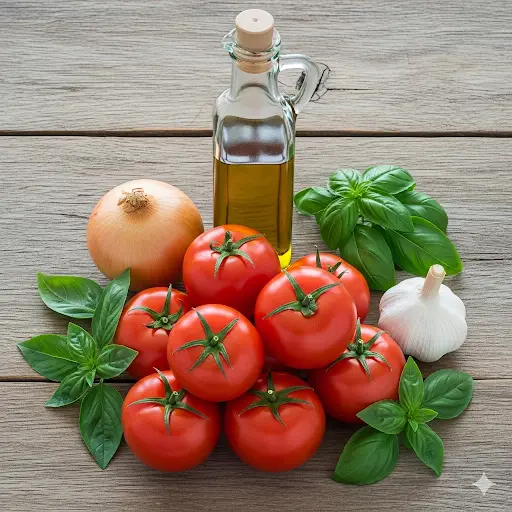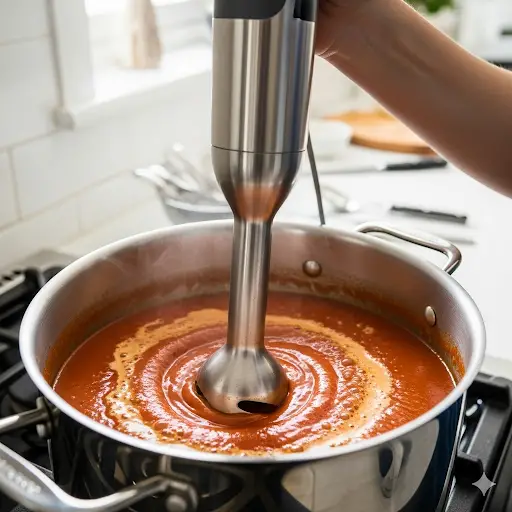Hey there, fellow foodie! Is there anything more comforting than a warm, steaming bowl of tomato soup? It’s the ultimate culinary hug, right? But let’s be honest, that stuff from a can, while nostalgic, just doesn’t compare to the real thing. I’m talking about a vibrant, sun-ripened, soul-soothing soup made from scratch. If you’ve been putting off making it because you think it’s too complicated, you’re in for a treat. We’re diving into the secrets of easy homemade tomato soup with fresh tomatoes, and I’m going to show you how to create a bowl of pure, unadulterated deliciousness with minimal fuss.
Why Homemade Tomato Soup is a Game-Changer
You might be thinking, “What’s the big deal? Tomato soup is tomato soup.” Oh, my friend, you couldn’t be more wrong! A homemade tomato soup is a revelation.
- Freshness You Can Taste: When you use fresh tomatoes, you get a flavor that’s bright, sweet, and a little bit tangy—a million miles away from the canned stuff. This is a truly fresh tomato soup.
- You’re in Control: No weird preservatives, no excessive sodium, and no high-fructose corn syrup. You control every ingredient, making it a perfect quick healthy meal.
- Surprisingly Easy: Despite what you might think, making homemade tomato soup recipe easy is incredibly simple. The oven does most of the work, and the results are pure magic. It’s a great example of delicious home made soups.
So, if you’re ready to ditch the can opener and embrace the flavor of fresh tomatoes, let’s get cooking!
Your Simple Ingredient List: The Key to Fresh Flavor
The beauty of this easy homemade tomato soup with fresh tomatoes recipe is its simplicity. You don’t need a lot of fancy ingredients, just a few key components to create a rich, complex flavor.
- Tomatoes: We’re going with Tomato Soup Recipes With Fresh Tomatoes, of course! About 2-3 pounds of ripe tomatoes are perfect. Roma tomatoes are my favorite because they’re meaty and have less water, but you can use any ripe tomato you have on hand.
- Onion & Garlic: These are the flavor foundation of our soup. A large onion and a few cloves of garlic are all you need.
- Olive Oil: A good quality olive oil is essential for roasting and sautéing.
- Broth: A low-sodium vegetable or chicken broth.
- Salt & Pepper: Your trusty seasonings.
- Optional but Recommended:
- Sugar: A pinch of sugar helps to balance the acidity of the tomatoes.
- Basil: Fresh basil leaves add a beautiful fresh, peppery flavor.
- Heavy Cream or Coconut Milk: A splash of cream or milk at the end will give you a luxurious creamy tomato soup.
The Secret to the Best Tomato Soup: Roasting Your Tomatoes
This is the one step that will elevate your easy homemade tomato soup with fresh tomatoes from good to absolutely incredible. Roasting the tomatoes and onions brings out their natural sweetness and gives the soup a deep, rich flavor that you just can’t get from simmering alone. It’s the key to the most flavorful Roasted Tomato Soup you’ve ever had.
- Prep Your Veggies: Halve your tomatoes and roughly chop your onion. Peel the garlic cloves, but leave them whole.
- Roast to Perfection: Spread the tomatoes, onions, and garlic on a baking sheet. Drizzle with a generous amount of olive oil and a sprinkle of salt and pepper.
- Bake: Roast at 400°F (200°C) for 30-40 minutes, or until the tomatoes are soft, a little caramelized, and the garlic is fragrant. This is a game-changer!
Step-by-Step Guide: How to Make Tomato Soup From Fresh Tomatoes
Alright, you’ve roasted your veggies. Now, let’s turn them into a beautiful soup! This is a simple Stove Top Tomato Soup that comes together in a flash.
- Sauté: In a large pot or Dutch oven, sauté a little extra onion and garlic in some olive oil until fragrant. This adds another layer of flavor.
- Add Your Roasted Veggies: Add your roasted tomatoes, onions, and garlic to the pot.
- Deglaze: Pour in a splash of vegetable or chicken broth and use a wooden spoon to scrape up all those delicious browned bits from the bottom of the pot. This is flavor gold!
- Simmer: Pour in the rest of your broth and your fresh basil leaves. Bring the soup to a gentle simmer and let it cook for 15-20 minutes to let all the flavors meld together.
- Blend: Now, here’s the fun part! You can either use an immersion blender to blend the soup directly in the pot until it’s perfectly smooth, or you can transfer the soup to a stand blender and blend it in batches.
- The Final Touches: Season with a little salt and pepper. If you like a little sweetness, add a pinch of sugar. If you want a creamy tomato soup, stir in a splash of heavy cream or coconut milk at the end.
- Serve and Enjoy! Serve your soup warm with a grilled cheese sandwich, a swirl of cream, or some croutons. A truly simple tomato soup recipe!
Creamy vs. Chunky: How to Achieve Your Desired Texture
The beauty of easy homemade tomato soup with fresh tomatoes is that you can make it exactly how you like it.
- For a creamy, smooth soup: Use a blender (immersion or stand) to blend the soup until it’s perfectly smooth. Pass it through a fine-mesh sieve for an extra silky texture.
- For a rustic, chunky soup: Use a potato masher or a fork to mash the tomatoes and onions, or blend it for just a few seconds to leave some chunks. You get to decide!
Variations and Customizations: Making Your Soup Your Own
Once you’ve mastered the basic tomato soup with fresh tomatoes recipe, you can start to get creative. This is where you make it your own!
- Add Protein: Add some cooked shredded chicken, meatballs, or white beans for a heartier, more filling meal.
- Make it Spicy: Add a pinch of red pepper flakes or a dash of sriracha for a spicy kick.
- Go Cheesy: Stir in some grated Parmesan cheese or a dollop of mascarpone at the end for an incredibly rich and cheesy soup.
- Make it a Tomato Paste Soup: If you’re in a pinch and don’t have fresh tomatoes, you can still make a delicious soup! Sauté some onion and garlic, then add a can of tomato paste and some broth. It’s a great option for a Tomato Paste Soup.
- Make it a “Grandma’s” Tomato Soup: My grandma used to add a touch of brown sugar and a little bit of butter to her soup. It’s a simple trick that makes a huge difference in flavor and richness. This is the secret to a truly great Grandmas Tomato Soup!
FAQs about Easy Homemade Tomato Soup
What kind of tomatoes are best for homemade tomato soup?
A1: Ripe, fresh tomatoes are best for homemade tomato soup. Roma tomatoes are a great choice because they have a low water content, but any ripe tomato will work well. The key is to use tomatoes that are in season for the best flavor.
Is it better to roast or boil tomatoes for soup?
A2: It is almost always better to roast tomatoes for soup. Roasting brings out the natural sweetness of the tomatoes and gives the soup a deep, rich, caramelized flavor that you can’t get from boiling. This is the key to a fantastic Roast Tomato Soup Recipe.
How do you make fresh tomato soup not bitter?
A3: To make fresh tomato soup not bitter, you can add a pinch of sugar or a little bit of baking soda to balance the acidity of the tomatoes. Roasting the tomatoes also helps to bring out their natural sweetness, which reduces bitterness.
What to add to tomato soup to make it taste better?
A4: To make tomato soup taste better, you can add a pinch of sugar, a splash of heavy cream, some fresh herbs like basil or thyme, or a dash of Worcestershire sauce. You can also add some roasted garlic and onions for a deeper flavor.
How do you thicken fresh tomato soup?
A5: To thicken fresh tomato soup, you can let it simmer uncovered for a few minutes to allow some of the liquid to evaporate, or you can stir in a cornstarch slurry (1 tablespoon of cornstarch mixed with 1 tablespoon of cold water). Adding a dollop of cream or yogurt at the end also helps to thicken it.
Can you make tomato soup without a blender?
A6: Yes, you can make tomato soup without a blender. After simmering, you can use a potato masher or a fork to mash the tomatoes and vegetables until they reach your desired consistency. It will be a more rustic, chunky soup.
What is the easiest way to peel tomatoes?
A7: The easiest way to peel tomatoes is to score an “X” on the bottom of each tomato, blanch them in boiling water for 30 seconds, and then immediately transfer them to an ice bath. The skins will slip right off.
Final Thoughts: Your Cozy Bowl Awaits!
So there you have it, fellow soup lover! The secrets to easy homemade tomato soup with fresh tomatoes are now yours. Ditch the can opener, embrace the magic of roasting, and get ready to create a bowl of pure, unadulterated comfort that is healthy, delicious, and incredibly satisfying. Go forth, make some soup, and prepare for a chorus of “oohs” and “aahs.” Your taste buds will thank you! 😉



